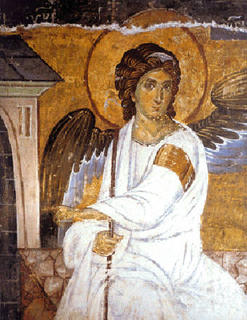The White Angel (believed to be Gabriel)
found at: http://www.byzantinesacredart.com/white-angel.html
Orthodox Iconography consists of portable/panel icons, frescoes (wall paintings on fresh plaster) and Orthodox mosaics. Some of the greatest, priceless treasures of Byzantine Iconography are adorning the walls of Eastern Orthodox churches in the form of frescoes and mosaics. Among those, Serbian early and medieval fresco painting takes a prominent place.
Built of stone, thousand years old Serbian churches carry some of the most majestic iconographic masterpieces that have, by some art historians, surpassed later Italian Renaissance frescoes in beauty and skill with which they were executed.
White Angel, painted in 1230 at the Mileseva Monastery, Serbia.
Archangel (believed to be Gabriel) at the entrance of Christ's empty tomb, announcing His resurrection to the myrrh-bearing women. Detail from the Resurrection fresco, Mileseva Monastery, Serbia
Famous Greek Icon Master Photios Kontoglou about Serbian frescoes
"... As far as technical execution is concerned, the wall paintings of Serbia disclose their creators as marvelous masters of the difficult art of wall painting, which in Italian is called fresco, because the artist paints on fresh plaster, put on at the time he is painting, when it is moist and thus retains the paint better. In such painting it is necessary that the painter have complete mastery of his work; he must be able to paint quickly, without hesitation and without making corrections, otherwise the plaster becomes dry, the wall does not absorb the paint, and it flakes off. Then it is necessary to scrape off the plaster, replaster the wall, and start painting again from the beginning. Now in this work the iconographers of Serbia were great masters, so much so that those who have some conception of the art of fresco painting are astonished. They surpassed many of the Italians who, more than others, worked at frescoes .."
Byzantine Sacred Art
found at: white-angel.html
Other links to Milaseva:
Mileseva - The White Angel (detail)
Mileseva Monastery photo - Alan Grant photos at pbase.com







